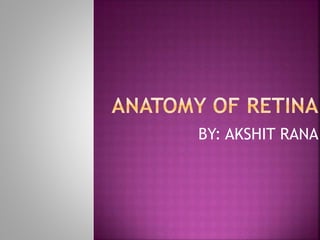
Anatomy of retina.pptx
- 2. Retina,the innermost tunic of eyeball, is a thin ,delicate and transparent membrane , which is the most highly developed tissue of the eye. It appears purplish-red due to the visual purple of the rods and underlying vascular choroid.,
- 3. Retina extends from ora-serrata. It is thickest in the peripapillary region and thinnest at ora-serrate. Ora-serrata is the last region where the retina ends and cilliary body starts.
- 4. Fundus refers to the dome shaped interior of the eyeball. Grossly,fundus can be divided into two ditinct regions; 1)POSTERIOR POLE 2)ANTERIOR POLE
- 5. It refers to the area of fundus posterior to the retinal equator Posterior pole of the retina includes 2 distinct regions: 1)OPTIC DISC 2)MACULA LUTEA
- 7. Also called as optic nerve head,pink coloured Average diameter of 1.5mm equal to 1DD. It is placed 3.4mm nasal to the fovea. Photoreceptors are absent here ; hence known as blind spot At the optic disc all the retinal layers terminate except the nerve fibres,which pass through the lamina cribrosa to run into the optic nerve.
- 8. A depression seen on the disc is called physiologicl cup.The central retinal artery and vein emerge through the centre of this cup.
- 9. It is also called as yellow spot. Fovea centralis, is the central depressed part of macula, it is about 1.5mm in diameter. An area about 0.8mm in diameter does not contain any retinal capillaries and is called foveal avascular zone.
- 10. In this area, there are no rods. Cones are tightly packed and it is the most sensitive part of retina It’s central part is called foveola. All other retinal layers are absent in this region.
- 12. It refers to the area bounded posteriorly by the retinal equator and anteriorly by ora serrata. Best examined by indirect opthalmoscopy and the Goldmann three mirror contact lens exmanination.
- 13. 1. PIGMENT EPITHELIUM 2. LAYER OF RODS AND CONES 3. EXTERNAL LIMTING MEMBRANE 4. OUTER NUCLEAR MEMBRANE 5. OUTER PLEXIFORM LAYER 6. INNER NUCLEAR LAYER 7. INNER PLEXIFORM LAYER 8. GANGLION CELL LAYER 9. NERVE FIBRE LAYER 10. INNER LIMITING MEMBRANE
- 14. It is theoutermost layer of the retina It consist of a single layer of cells containing the pigment melanin. Around the optic disc,they are heaped up as choroidal ring. It ia firmly adherent to the underlying basal lamina of the choroid.
- 15. Rod and Cones are the end organs of vision and are also known as photoreceptors. Rods contain a photosensitive substance rhodopsin and helps in peripheral vison of low illumination(scotopic vision) Cones also contain a photosensitive substance and helps in highly discriminatory central vision(photopic vision) and colour vision.
- 16. It is a fenestrated membrane , on whuch rods and cones rest and their processes pierce.
- 17. It consists of nuclei of the rods and cones. Cone nuclei are large and more oval and carry a layer of cytoplasm.
- 18. The innermost portion of each rod and cone cell is swollen with lateral processes known as spherules and pedicles respectively. This layer consist of connections of rod spherules and cone pedicles with the dendrites of bipolar cells and horizontal cells.
- 19. It mainly consists of nuclei of bipolar cells. It also contains nuclei of Amarcrine and Muller’s cells. The bipolar cells constitute the first order neurons in visual pathway.
- 20. It essentially consists of connections of bipolar cells with the ganglion cells and amacrine cells.
- 21. It mainly contains cell bodies of ganglion cells There are 2 types of ganglion cells, 1)MIDGET GANGLION CELLS-present in macular region 2)POLYSYNAPTIC GANGLION CELLS- lie predominantly in the peripheral retina.
- 22. It consists of axons of ganglion cells, running parallel to the retinal surface. The layer increases in depth as it coverges to optic disc It passes through the lamina cribrosa to form the optic nerve.
- 23. It is the innermost layer and seprates the retina from the vitreous. It is formed by the union of terminal fibres of the muller’s fibres. It is essentially a basement membrane.
- 24. Outer 4 layers of the retina-CHOROIDAL VESSELS. Inner 6 layers- CENTRAL RETINAL ARTERY which is a branch of opthalmic artery . Fovera is aavascular but partially gets blood supply from choroidal vessekls. Macula- CENTRAL RETINAL ARTERY and CILIORETINAL ARTERY.
- 25. Central retinal artery emerges from the centre of the physiological cup of the optic disc and divides into 4 branches. These are END ARTERIES i.e. They do not anastomose with each other.